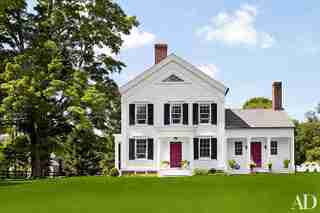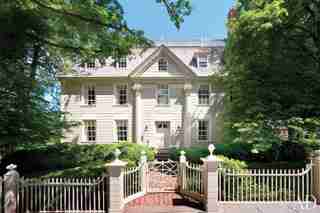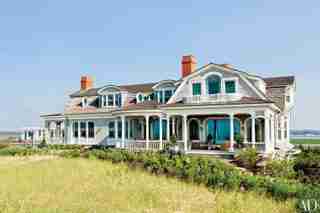Residential or domestic architecture has evolved from early shelters with an emphasis on function and protection to modern-day dwellings that showcase craftsmanship, comfort, and ornamental details. We’ve gathered gorgeous examples of the most popular house styles from the AD archives. Get to know these types of houses, see how top architects interpret classic looks, and find inspiration for your next building project or real-estate search. From ornate Tudor Revival to relaxed Shingle Style , there’s an aesthetic to suit every taste.

Greek Revival
Drawing inspiration from ancient Greece, the style found popularity during the mid-1800s. Greek Revival homes often feature columns or pilasters, symmetrical proportions, and white-painted exteriors.
A Benjamin Moore white brightens the Greek Revival farmhouse at Clove Brook Farm, lamp impresario Christopher Spitzmiller and decorator Sam Allen’s getaway in New York’s Hudson Valley. Architectural designer Jonathan Parisen advised on the renovation, Harry Heissmann collaborated on the interiors, and P. Allen Smith assisted with the landscape design.

Georgian
The Georgian style dominated between 1714 and 1830 (during the reigns of King George I through King George IV) and is known for its focus on symmetry and classical details.
Engaged Corinthian columns distinguish the main façade of the Lindens, a 1754 Georgian residence in Washington, D.C., that was recently redecorated by Gomez Associates Inc.

Shingle Style
Particularly prevalent on the East Coast, Shingle Style homes are distinguished by their wood-shingled exteriors, irregular rooflines, and expansive porches. The style became popular during the late 19th century and borrows elements from Queen Anne and Colonial Revival architecture.
Porches and balconies lend a summery look to an East Quogue, New York, house devised by Robert A.M. Stern Architects and decorated by design firm S. R. Gambrel.
International Style
Known for their use of glass, steel, and concrete, International Style designs placed importance on function rather than ornamentation. The style took off in the early 20th century, and its practitioners include midcentury-modern architects such as John Lautner, Rudolph Schindler, Richard Neutra, and Eero Saarinen.
Michael Boyd of BoydDesign restored the Steinman House in Malibu, California, built by architects Craig Ellwood and Jerrold Lomax in 1956 and now owned by Holly and Albert Baril. The pool terrace mixes vintage seating by Danny Ho Fong, Harry Bertoia, and the midcentury firm Van Keppel-Green.
Neoclassical
In fashion during the 18th and 19th centuries, neoclassical architecture employs the principles and elements of Roman and Greek design.
Architects Ernesto Buch, Maria de la Guardia, and Teofilo Victoria designed a neoclassical entrance for a residence in Indian Creek Village, Florida.
Tudor Revival
Harking back to the 16th century, Tudor Revival houses recall the stately homes built during the reign of the Tudor monarchs in England. The style was particularly popular in the 1920s and features half-timbered gables, diamond-pane windows, and brick or stone exteriors.
With characteristic bold style, Peter Marino created rich, exotic interiors for a 1929 Tudor Revival house in Greenwich, Connecticut.
Spanish Colonial Revival
Spanish Colonial Revival style, which was popular in the U.S. in the early 20th century, includes many characteristics of the earlier architectural movement, such as stucco walls; low-pitched, clay-tile roofs; and decorative tile and ironwork.
Designer Stephen Shadley helped actress Diane Keaton restore her circa-1927 Spanish Colonial Revival house in Bel-Air, California.
Italianate
Americans went wild for Italianate homes in the mid- to late-19th century. The style borrows from the architecture of Italian villas and features tall windows, square cupolas, and small entry porches.
Jewelry designer Ippolita Rostagno converted her 19th-century Italianate brownstone in Brooklyn from a two-family residence into a single cohesive home for herself.
Colonial Revival
The Colonial Revival style emerged after the centennial and continued into the mid-20th century. These homes are distinguished by symmetrical façades and entry porches.
Hilary and Wilbur Ross’s Colonial Revival house in the Hamptons was built in the early 1900s.
Federal Style
The Federal style rose to prominence after the American Revolution and features simple exteriors, rectangular structures, windows with keystone lintels, and semicircular fanlights above the entrance.
Bruce Shostak and Craig Fitt’s brick Federal-style house in upstate New York is painted in a Benjamin Moore white.
Gothic Revival
Gothic Revival design brought the romantic style of medieval England and France to the U.S. in the 1830s. Common elements include masonry exteriors; arched, leaded-glass windows; and tracery patterns.
The 19th-century Gothic Revival–style Highclere Castle , home of the Earls of Carnarvon, is located in Hampshire, England, and served as the filming location of Downton Abbey.